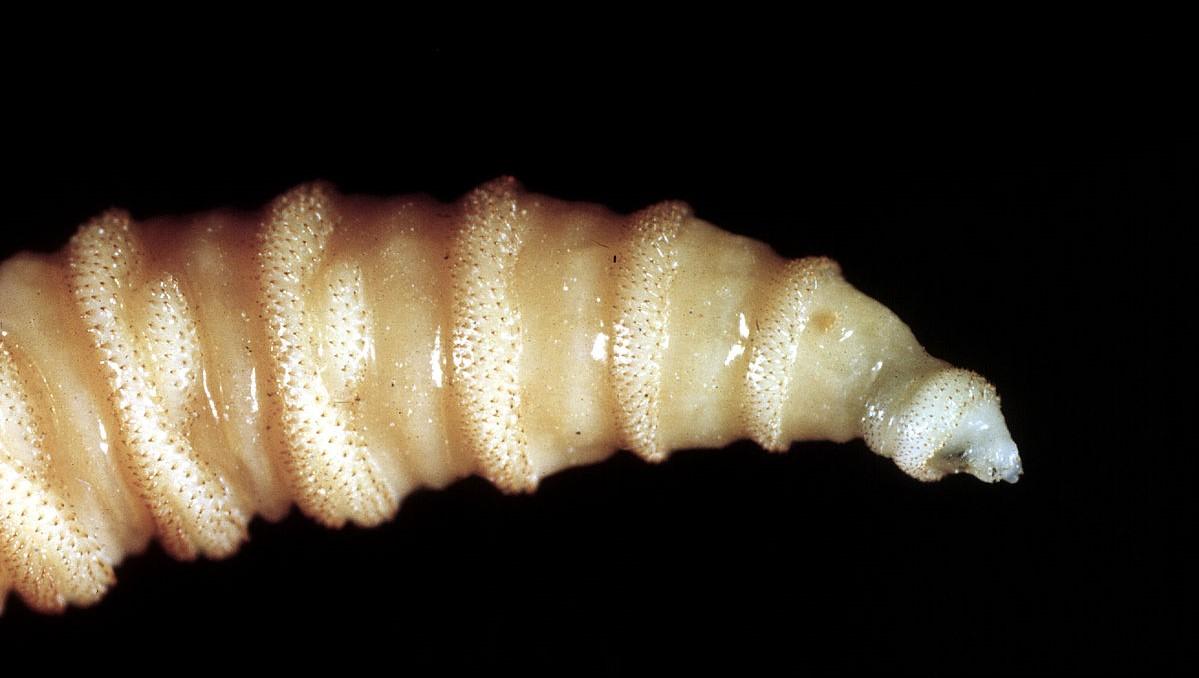Screwworm is back — and it’s bad news for Florida’s endangered deer
A screwworm fly larva.
There’s a real-life horror story unfolding right now in the Florida Keys.
Once a common livestock pest, the flesh-eating New World screwworm was all but eradicated in the US in 1982, after a decadeslong effort. But now, screwworm has been spotted on more than half a dozen of Florida’s islands — and the new infestation is imperiling the tiny, endangered Key deer.
Over 100 deer from the estimated 1,000-deer population have been euthanized in recent months because of untreatable screwworm infections. Teams trying to save the deer are battling the clock and a persistent parasite.
“What makes this fly different than all the other blowflies we have is that it specifically goes after the living tissue and burrows deeper and deeper,” says Phillip Kaufman, a veterinary entomologist at the University of Florida.
He explains that the female fly lays her eggs in open wounds. When the eggs hatch, the larvae begin to spiral down into living tissue, creating a larger wound that can draw in more flies. It’s a grisly infestation, and Kaufman says, if left untreated, the physical damage caused by screwworms can kill animals within a week or two.
Chris Eggleston has seen the screwworm’s effects on Key deer firsthand. Eggleston, acting manager at the National Key Deer Refuge in Big Pine Key, says deer at the refuge started turning up with stranger-than-normal infections late this summer.
“We see wounded deer and respond to the situation, but they started to show up with worse and worse infections and the infections were pretty, well, frankly kind of horrifying,” he says. “You know, we hadn't seen wounds that had fly larvae in them previously.”
Florida declared an agricultural state of emergency and established quarantines to keep the screwworm from spreading out of the Keys onto the mainland. To zap the infestation, federal and state agencies are leaning hard on the tool that helped eradicate the blowfly from the United States in the first place: the “sterile insect technique,” in which millions upon millions of sterile male screwworm flies are released into the wild to breed.
Developed by the US Department of Agriculture in the 1950s, the technique was used to wipe out self-sustaining screwworm populations in the country by the 1960s, and blot out occasional reinfestations (like the last major one, in 1982). It’s also used as part of a permanent “sterile fly barrier” at the Darien Gap, where the US has partnered with Panama to regularly drop sterile flies by airplane over parts of Panama and Colombia.
Kaufman takes us through the process: The flies are irradiated in the pupal stage, sterilizing the males. Next, they’re let loose. And when a female mates with a sterilized male, that’s it — finis. “She will not produce any viable offspring and essentially ends her genetic line,” he says.
The technique is being used on with millions of insects in Panama, Kaufman says. But fighting Florida’s screwworm outbreak with sterile flies will take time — which the Key deer don’t have much of.
“This process is going to take about six months before they're going to be probably very sure that they've eradicated it,” Kaufman says. “Now the [deer] numbers are … going to progressively drop. But there are other things being done to assist the deer, such as trying to treat them with medications that are going to kill any fly larvae that might establish on them before they get too large.”
At the National Key Deer Refuge, Eggleston and others are using every trick they can think of to medicate the little deer, including some that they’d eschew under normal circumstances.
“There's a group [of deer] out here, sort of a subset of the population, that will come right up to you and eat out of your hand,” Eggleston says. “And that's something that we've always discouraged in the past, but right now it's kind of working in our favor in this emergency situation.”
Eggleston’s team is hand-feeding deer, giving them bread laced with ivermectin, an antiparasitic drug that can prevent infections, as well as treat those in the early stages. They’re hoping to treat the deer every week, and are painting the animals (those that get close enough) with a nontoxic paint, indicating the day of the week they were medicated. But many deer are too shy to take the bait, staying a few feet away, or hiding out in the woods altogether.
“So, for those, we may have to try a different technique,” Eggleston says. “We may have to put out … feed blocks that have this drug in it, or maybe we figure out a way to get this on them topically and keep those ones safe.”
As federal, state and local organizations work to halt screwworm devastation in Florida’s Key deer population, there’s work for citizens to do as well: checking pets that have been in the area, to make sure they aren’t carrying flies or larva back to the mainland.
“It is critical that we keep the infestation from spreading, and keep it from particular off of the peninsular Florida, where we have a much more diverse wildlife as well as our domestic livestock,” Kaufman says.
This article is based on an interview that aired on PRI's Science Friday.
